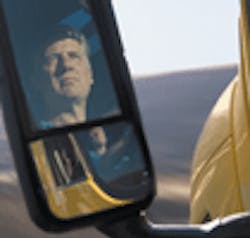A recent study by international consulting firm ABI Research indicates that demand for driver-monitoring technology – particularly camera-based systems designed to thwart drowsy and distracted driving– is poised to pick up sharply within the next several years .
While David Alexander, ABI’s principal analyst, stressed that while governments have not yet proposed financial incentives to encourage the public to invest in advanced safety systems, many countries have set goals to reduce traffic accidents – and keeping drivers alert has the potential to make a difference in those crash calculations, he said.
For that reason, he said the market for driver monitoring systems “will be in its infancy until 2013, at which point we expect volumes to start growing strongly. We project that, by 2015, the global market value will exceed $1 billion.”
Larry Fisher, ABI’s research director-NextGen, told FleetOwner that a wide variety of active safety and driver assistance systems – such as lane departure warning and active braking technologies – are making steady progress down the long migration path from high-end exclusivity to mass-market appeal as a way to enhance existing safety and/or convenience for both commercial fleets and everyday motorists.
“The biggest advantage for a driver-monitoring system that analyzes the face using a camera is that drowsiness or distraction sometimes can be detected before the vehicle behavior changes enough for a data-analysis or telematics system to register a problem,” Fisher explained.
“In Europe, some features – such as lane departure warning (LDW) and active cruise control (ACC) – are being mandated on all new heavy commercial vehicles beginning in 2013,” he added. “We expect this approach to be adopted in other countries. Some systems such as LDW and ACC have been available for longer on commercial vehicles than cars because the higher cost can be justified by some fleet operators. Cost is the only factor limiting wide acceptance.”
As advanced sensor-based devices such as radar and cameras are introduced, however, the challenge for manufacturers will be to deliver as much added value from these components as possible, said Fisher.
“Safety has always been difficult to sell on its own, but convenience is easier,” he noted. “The other contributing factor is new sensor technology that promises significantly lower prices. Governments are evaluating the systems today, but mandated features are some years in the future for consumer vehicles. Insurance companies have also been reluctant to offer discounts for driver-monitoring systems so far, but it is a possibility once significant real-world experience has been documented.”
Fisher also pointed out that ABI’s study indicates data analysis-based systems will lead the market for driver-monitoring features, at least through 2015. “However, the direct approach of analyzing the driver’s face has some advantages over data analysis, and we also expect installations of driver-camera systems to increase over the forecast period, although not as quickly,” he added.
About the Author
Sean Kilcarr
Editor in Chief
Sean Kilcarr is a former longtime FleetOwner senior editor who wrote for the publication from 2000 to 2018. He served as editor-in-chief from 2017 to 2018.
